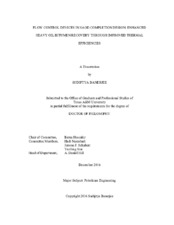| dc.description.abstract | The volume of heavy oil/bitumen recoverable worldwide is vast in quantity but difficult and energy intensive to extract due to the high in-situ oil viscosity of these unconventional plays. One method of thermal recovery, steam-assisted gravity drainage (SAGD), has proven a commercial success in heavy oil/bitumen production by using steam to raise the temperature of heavy oil/bitumen in the reservoir with a resulting lower hydrocarbon viscosity, shifting the relative mobility of reservoir oil to one favorable for extraction via horizontal wells.
However, geological and reservoir heterogeneity often complicate this task resulting in uneven production rates, higher operational costs, and stranded heavy oil/bitumen. This work theorizes that SAGD recovery is improved using flow control devices (FCDs) to force conformance in SAGD laterals. To test this theory, a novel protocol and test flow loop was developed to measure pressure drop across an autonomous hybrid FCD while flowing multiphase mixtures containing steam. This laboratory data was used to qualify existing pressure drop correlations and determine if nitrogen gas, a common test gas to describe FCD pressure drop response, creates suitable data for modeling steam systems. Finally, the flow loop was used to induce a steam “flash”, a transition of water at saturation temperature to vapor due to a suddenly decreased pressure environment, within the FCD to determine if steam flashing changes expected pressure drops.
Using linear regression, a correlation of expected pressure drop across the autonomous hybrid FCD for mixtures of heavy oil/bitumen, water, and steam was generated. Existing correlations proved inadequate for mixtures containing steam, consistently underestimating pressure drop across the FCD. However, the empirical correlation of this research highly matched laboratory data with an R-squared value of 0.94. A secondary linear model captured modifications in FCD behavior due to steam flashing. This second model also exhibited a strong goodness-of-fit with an R-squared value of 0.96. For both empirical correlations, p-values less than 0.05 were easily obtained, inferring the statistical significance of each correlation.
Correlations generated in this research were added to the REVEAL™ reservoir simulation package to accurately forecast FCD impact on SAGD well pair performance. Simulating a four year production period for SAGD well pairs in Albertan reservoirs consistently show that FCD usage improved bitumen recovery by 50% or more while simultaneously decreasing cumulative steam/oil ratios (cSOR) by 1-2 m^3/m^3. The mechanism of action for this change was due largely to improved steam chamber conformance and by eliminating steam breakthrough events in the producer. Net Present Value (NPV) analysis of improvements with the additional cost of FCD completion tools unfailingly showed a strong economic argument for the use of FCDs to improve thermal efficiency. | en |


